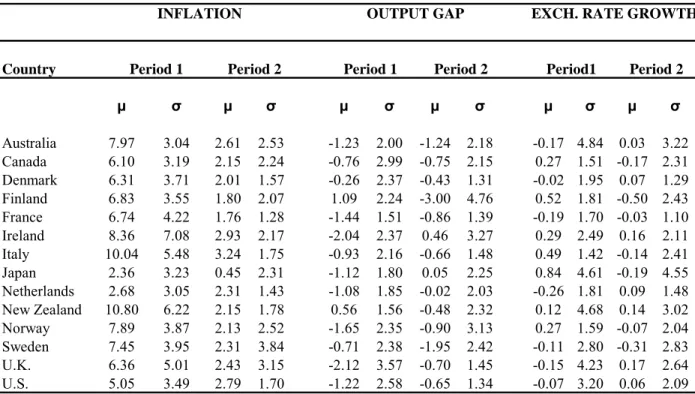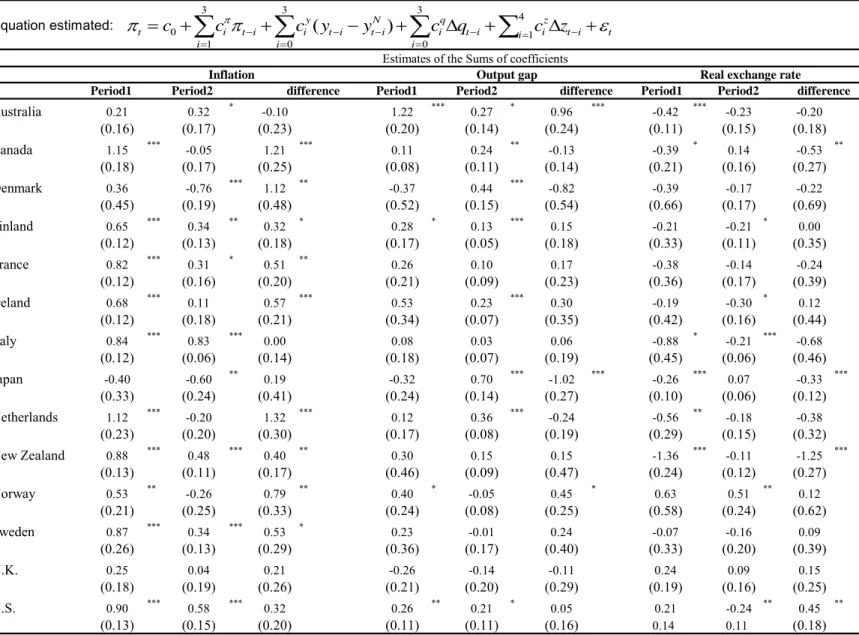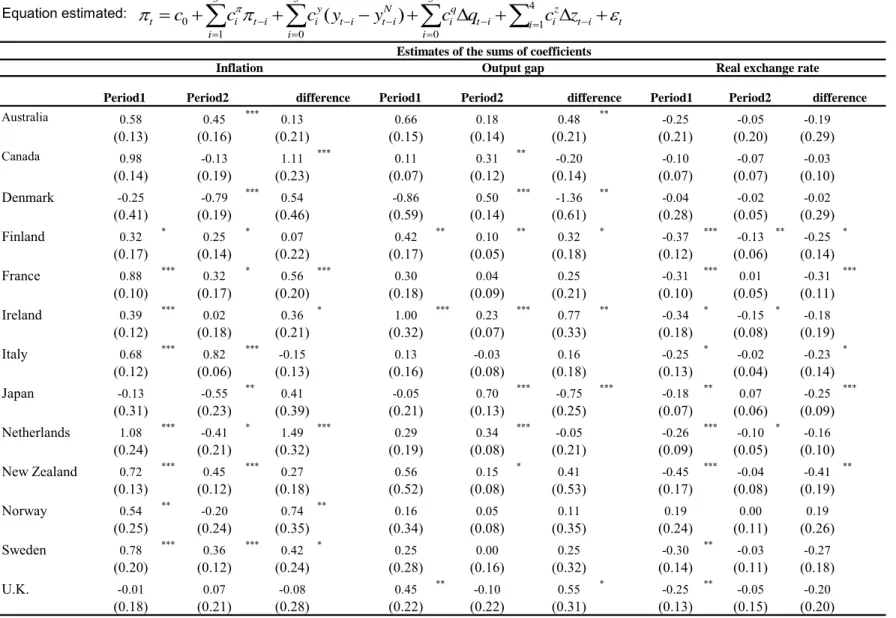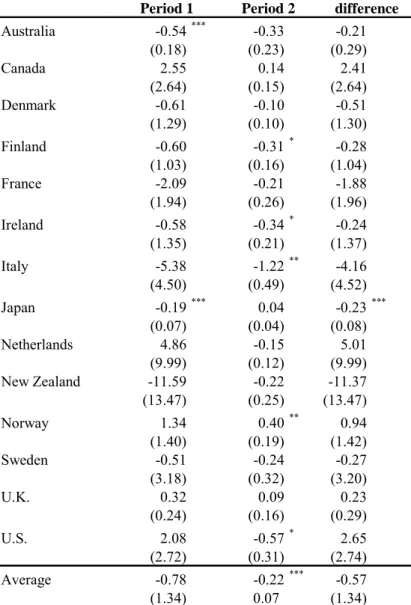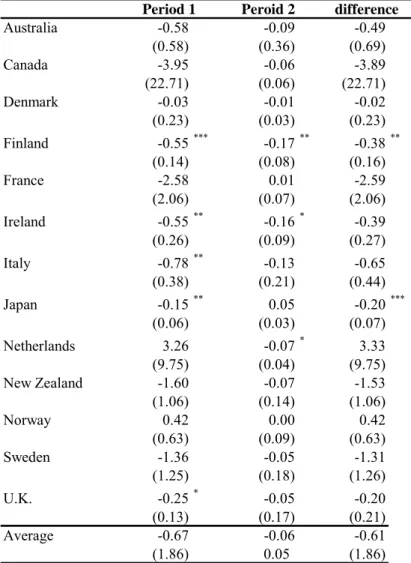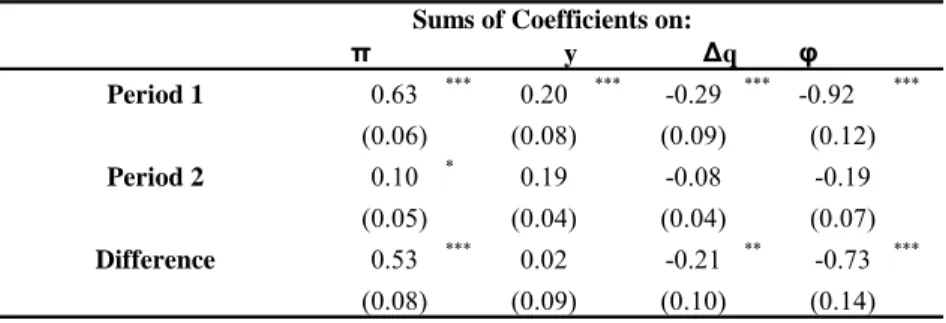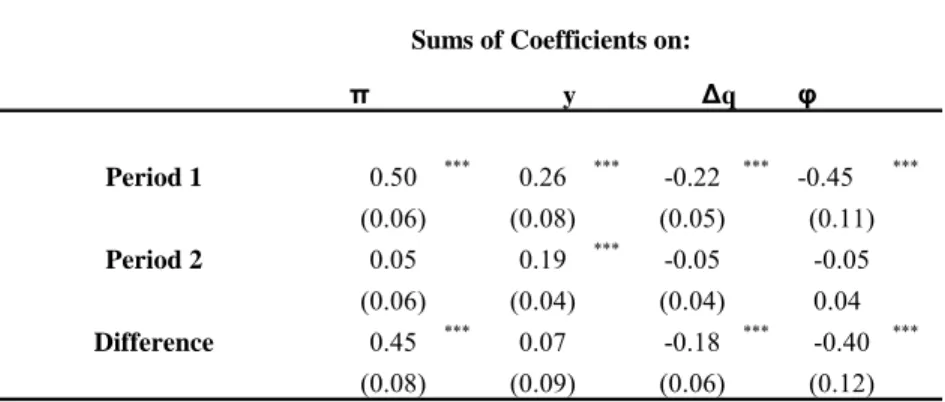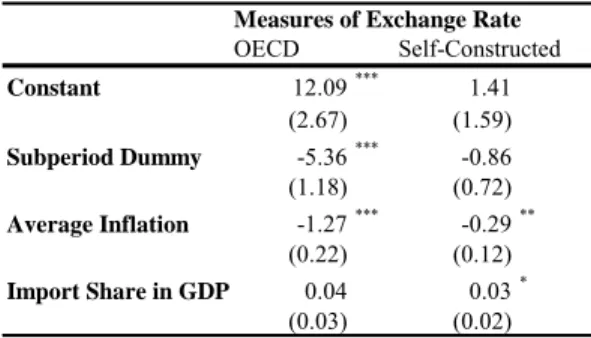It is suggested that the recent reduction in the real exchange rate pass-through can be attributed in part to the low-inflation environment of the 1990s. A smaller but equally important part of the literature concentrates on the macroeconomic exchange rate pass-through to aggregate price indices (Bachetta and van Wincoop 2003, Campa and Goldberg 2006, Gagnon and Ihrig 2004). 3 See Goldberg and Knetter for a review of the literature on the exchange rate pass-through to import prices.
Under this definition, an increase in the real exchange rate is interpreted as a real appreciation of the domestic currency. Again, as in Ball (1999), Svensson (1998) and Razin and Yuen (2001), the strength of inflation's response to changes in the real exchange rate depends on the degree of openness of the economy (i.e. the share of imported goods). goods in the CPI).
Inflation Dynamics
First, it accounts for the influence of the central bank's credibility on the real exchange rate passage. Thus, a decrease in the fraction of foreign firms in the economy causes a reduction in real exchange rate pass-through at the aggregate level. As noted earlier, only foreign firms change their prices in response to real exchange rate fluctuations.
Empirical Model
In addition to the three parameters described above, the long-term exchange rate flow is affected by the parameters α, k1 and ω. Equation (16) reveals that the persistence of inflation decreases with increases in the central bank's credibility parameter (α ), the degree of real rigidity (k1) and the central bank's commitment to low inflation (ω). A reduction in the persistence of inflation will lead to a decrease in the long-term effect of real exchange rate fluctuations on inflation.
Note that this paper is not the first to consider possible theoretical explanations for changes in exchange rate pass-through. One could argue that it is the increase in the central bank's credibility that reduces inflation persistence, and thus the perceived persistence of cost changes. Gagnon and Ihrig (2004) also point to the relationship between exchange rate permeability to monetary authority's credibility and strength in response to inflation deviations from target.
In this section, I present the empirical model used in this study, explain the proposed estimation method, and describe the data. In this paper, I will focus on the long-run pass-through coefficient (denoted by cqj, where j indexes countries), which is defined as.
Estimation Methodology
With such estimates in hand, I can then proceed as usual to estimate the system using the FGLS (Greene 1997). The procedure generates Phillips curve estimates for the open economy for all countries in the sample. While the estimates of the individual country coefficients are presented, my discussion focuses on the average coefficients between countries.
The main reason for using such an approach is that the purpose of this paper is to address fairly recent changes in the structure of the open economy Phillips curve. This approach also allows some general conclusions to be made about the structural break in the open economy Phillips curve since the 1990s. The variances and covariances of individual country coefficients can be obtained from an FGLS estimation of the Phillips curve system of equations. for the countries panel.
Data
To check the robustness of my estimation results to the choice of real exchange rate data, I also calculate an alternative measure of the real exchange rate defined as in equation (2). The CPI is used to measure P* to calculate the real exchange rate between the country's currency and the US. Compared to a set of real effective exchange rates, this alternative is a narrower measure of the real exchange rate, which may make it less attractive in theory.
On the other hand, given the problems with the measurement of the real effective exchange rate, this measure is more reliable. Summary statistics for CPI inflation, the output gap and the real exchange rate growth rate are summarized in Table 1. For all countries in the sample, average inflation in the first sub-period is higher than in the later period.
Furthermore, the later sub-period is also characterized by lower inflation volatility (with the exception of Sweden and Australia, the inflation variation is significantly greater in the first period). For most countries, the average gap is negative (indicating that actual output is below potential) for both periods (the output gap is positive only for Finland in the first period). This section presents the evidence supporting the claim that a structural break in the relationship between inflation and the real exchange rate occurred during the 1990s.
Evidence of a Decline in the Real Exchange Rate Pass-Through
The first panel of Table 4 shows estimation results obtained using OECD real effective exchange rate data, and the second panel presents estimation results obtained using the alternative real exchange rate data. The table reports the sum of inflation coefficients (denoted by π in the table), output gap (denoted by y), and the real exchange rate growth rate (Δq). The last column in the table shows the long-term transmission coefficient (denoted LRPT) for the average Phillips curve (denoted φ).
As shown in Table 4, for the countries as a group, both inflation persistence (measured by the sum of coefficients on inflation lags) and the correlation between real exchange rate growth and inflation (measured by the sum of coefficients on the real exchange rate rate) decreased significantly between the two periods. The decline in inflation persistence is consistent with other researchers' findings of a reduction in inflation persistence over time (Ball and Sheridan 2003, Sheridan 2001). Recall that while a decrease in inflation persistence does not change the effect of real exchange rate shocks on inflation, it reduces the long-run effect.
Thus, it is no surprise that we see a significant drop in the long-term pass-through coefficient. When the OECD real effective exchange rate is used, the estimation results suggest that a 1 percent real appreciation of the domestic currency (increase in the real exchange rate) ultimately leads to a 0.92 percent decrease in inflation in the previous subperiod. The long-run pass-through coefficient for the second subperiod is not significantly different from zero, indicating no significant effect of real exchange rate changes on inflation in the later period.
As with the OECD real exchange rate, the long-run exchange rate pass-through coefficient estimated with the alternative real exchange rate is not significantly different from zero.
The Determinants of Real Exchange Rate Pass-Through: Time Series Cross- Section Results
I use average inflation over the decade as a measure of the share of flexible pricing firms in the economy. The aim of this exercise is to determine whether two of the proposed theoretical determinants of the pass-through of the real exchange rate – i.e. the share of firms with flexible prices and the openness of the economy – do in fact influence the response of inflation to the real affect exchange rate. exchange rate fluctuations. For each country in the sample, I already have estimates of the long-term pass-through coefficients (shown in Table 3).
I estimate the model twice and calculate the overall inflation response based on the coefficients estimated using the OECD and alternative real exchange rate data. The table shows that average inflation for the sub-period has a statistically significant impact on the response of inflation to real exchange rate movements. For the estimate based on OECD real exchange rate series, a 1 percentage point increase in average inflation for the subperiod produces a 1.27 percent increase in the long-term pass-through of exchange rates.
Using self-constructed real exchange rate data, a 1 percent increase in the average inflation rate yields an additional 0.29 percent increase in the same parameter. When the long-run exchange rate pass-through coefficient is obtained using the OECD real effective exchange rate series, the sub-period model also has a significant effect on the long-run exchange rate pass-through, indicating that the pass-through was higher in the 1990s than in the later period. When the alternative real exchange rate is used, the coefficient of the share of imports in GDP is significantly different from zero and is positive, indicating that the increase in the opening of inflation decreased the transmission of the exchange rate.
This reduction, in turn, has contributed to a decrease in the transmission of real exchange rate changes to inflation.
How Much Do Determinants of Real Exchange Rate Pass-Through Explain?
Based on these observations, it can be concluded that the low-inflation environment that began in the 1990s led to a reduction in the fraction of firms with flexible prices in the economy. This paper presents a theoretical framework for analyzing exchange rate pass-through and an empirical investigation of the possibility that exchange rate pass-through has declined since the 1990s compared to the 1980s. Therefore, in an open economy, real fluctuations of the exchange rate will cause fluctuations in the inflation rate.
These are the degree of transfer of the real exchange rate to the prices of individual firms (which depends on the elasticity of demand and the cost functions faced by individual firms), the share of imports in the CPI basket, the share of flexible -price firms in the economy, and the credibility of the monetary authority. Empirical research for fourteen OECD countries confirms other authors' suggestions of a decline in exchange rate pass-through in the 1990s (eg Cunningham and Haldane 2000, Garcia and Restrepo 2001, McCarthy 1999). This article attempts to find an explanation for the weakening relationship between the real exchange rate and CPI inflation.
A hypothesis is that the decrease in exchange rate pass-through is partly caused by a reduction in the fraction of flexible-price companies in the economy. This finding is consistent with the conclusions of Taylor (1999), who asserts that "the decline in throughput or pricing power is due to the low inflation environment recently achieved in many countries." The implication of the analysis presented in this paper is that the observed reduction in the real exchange rate pass-through cannot be considered a permanent change.
Should the level of inflation and the persistence of inflation increase in the future (as some fear may happen in the US in the near future), we will see an increase in the real exchange rate flow. Potential GDP is defined in the Economic Outlook as the level of output an economy can produce at a constant rate of inflation. Haldane (2000) "The Monetary Transmission Mechanism in the United Kingdom: Pass Through and Policy Rules," Central Bank of Chile Working Papers, no.
